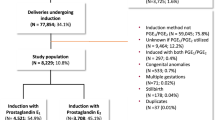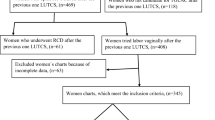Abstract
OBJECTIVE:To determine whether obstetricians with high rates of induction for the indication of fetal macrosomia had higher or lower cesarean section rates.
STUDY DESIGN:Data were analyzed from 1432 deliveries with birthweights >4000 g. Four physician populations were identified: a faculty service and three groups of private practitioners with induction rates 20% to 40%, 40% to 60% and >60%. The average cesarean section rate was determined for each group as well as the percentage of each group's deliveries occurring before 39 weeks, at 39, at 40, and after 40 weeks. In addition, the relative risk of cesarean delivery was calculated for the entire study population.
RESULTS:No correlation was found between the rate of induction of labor and the rate of cesarean section. Delivery of nulliparous and multiparous patients after 40 weeks carried an increased risk of cesarean section. Delivery of multiparous patients before 39 weeks did also. Obstetricians with induction rates >40% significantly decreased the incidence of delivery after 40 weeks, which lowered their cesarean section rates, but no net lowering occurred because of increased rate of cesarean section <39 weeks.
CONCLUSION:A fetal weight of 4000 g or more is not an indication for induction of labor. For multiparous patients, induction at 38 weeks or before is associated with an increased rate of cesarean delivery.
This is a preview of subscription content, access via your institution
Access options
Subscribe to this journal
Receive 12 print issues and online access
$259.00 per year
only $21.58 per issue
Buy this article
- Purchase on Springer Link
- Instant access to full article PDF
Prices may be subject to local taxes which are calculated during checkout
Similar content being viewed by others
References
Friesen CD, Miller AM, Rayburn WF Influence of spontaneous or induced labor on delivering the macrosomic fetus Am J Perinatol 1995 12(1) 63–6
Gonen O, Rosen DJ, Dolfin Z, Tepper R, Markov S, Feijgin MD Induction of labor versus expectant management in macrosomia: a randomized study Obstet Gynecol 1997 89 (6)913–7
Conway DL, Langer O Elective delivery of infants with macrosomia in diabetic women: reduced shoulder dystocia versus increased cesarean deliveries Am J Obstet Gynecol 1998 178 (5)922–5
Mathews TJ Trends in stimulation and induction of labor 1989–1995 Stat Bull — Metropolitan Insurance Companies 1997 78(4)20–6
Prysak M, Castronova FC Elective induction versus spontaneous labor: a case-controlled analysis of safety and efficiency Obstet Gynecol 1998 92 (1)47–52
Author information
Authors and Affiliations
Rights and permissions
About this article
Cite this article
Horrigan, T. Physicians Who Induce Labor for Fetal Macrosomia Do Not Reduce Cesarean Delivery Rates. J Perinatol 21, 93–96 (2001). https://doi.org/10.1038/sj.jp.7200500
Published:
Issue Date:
DOI: https://doi.org/10.1038/sj.jp.7200500
This article is cited by
-
Does induction of labor for constitutionally large-for-gestational-age fetuses identified in utero reduce maternal morbidity?
BMC Pregnancy and Childbirth (2014)



